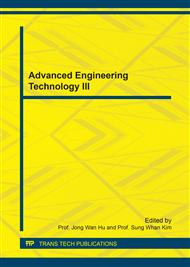[1]
BP Statistical Review of World Energy, sixty fifth ed., (2016).
Google Scholar
[2]
H. Tsubomura, M. Matsumura, Y. Nomura, T. Amamiya, Dye sensitised zinc oxide: aqueous electrolyte: platinum photocell, Nature 261 (1976) 402-403.
DOI: 10.1038/261402a0
Google Scholar
[3]
B. O'Regan, M. Grätzel, A low-cost, high-efficiency solar cell based on dye-sensitized colloidal TiO2 films, Nature 353 (1991) 737-740.
DOI: 10.1038/353737a0
Google Scholar
[4]
A. Fujishima, K. Honda, Electrochemical photolysis of water at a semiconductor electrode, Nature 238 (1972) 37-38.
DOI: 10.1038/238037a0
Google Scholar
[5]
M. Grätzel, Photoelectrochemical cells, Nature 414 (2001) 338-344.
Google Scholar
[6]
Y. L. Lai, S. H. Chen, J. H. Lu, J. S. Ting, T. Y. Tsai, A new low-temperature fabrication method of dye-sensitized solar cells, Lect. Notes Electr. Eng. 234 (2013) 975-980.
DOI: 10.1007/978-1-4614-6747-2_113
Google Scholar
[7]
W. J. Lee, E. Ramasamy, D. Y. Lee, J. S. Song, Grid type dye-sensitized solar cell module with carbon counter electrode, J. Photochem. Photobiol. A 194 (2008) 27-30.
DOI: 10.1016/j.jphotochem.2007.07.010
Google Scholar
[8]
Y. L. Lai, L. Y. Tang, Advanced fabrication technology of nano-silver dye-sensitized solar cells, J. Precis. Mach. Manuf. Technol. 6 (2016) 1-10.
Google Scholar
[9]
I. N. Obotowo, I. B. Obot, U. J. Ekpe, Organic sensitizers for dye-sensitized solar cell (DSSC): properties from computation, progress and future perspectives, J. Mol. Struct. 1122 (2016) 80-87.
DOI: 10.1016/j.molstruc.2016.05.080
Google Scholar
[10]
I. A. Sahito, K. C. Sun, A. A. Arbab, M. B. Qadir, S. H. Jeong, Graphene coated cotton fabric as textile structured counter electrode for DSSC, Electrochim. Acta 173 (2015) 164-171.
DOI: 10.1016/j.electacta.2015.05.035
Google Scholar
[11]
H. Imai, Y. Takei, K. Shimizu, M. Matsuda, H. Hirashima, Direct preparation of anatase TiO2 nanotubes in porous alumina membranes, J. Mater. Chem. 9 (1999) 2971-2972.
DOI: 10.1039/a906005g
Google Scholar
[12]
H. Imai, M. Matsuta, K. Shimizu, H. Hirashima, N. Negishi, Preparation of TiO2 fibers with well-organized structures, J. Mater. Chem. 10 (2000) 2005-(2006).
DOI: 10.1039/b004543h
Google Scholar
[13]
T. Kasuga, M. Hiramatsu, A. Hoson, T. Sekino, K. Niihara, Formation of titanium oxide nanotube, Langmuir 14 (1998) 3160-3163.
DOI: 10.1021/la9713816
Google Scholar
[14]
T. Kasuga, M. Hiramatsu, A. Hoson, T. Sekino, K. Niihara, Titania nanotubes prepared by chemical processing, Adv. Mater. 11 (1999) 1307-1311.
DOI: 10.1002/(sici)1521-4095(199910)11:15<1307::aid-adma1307>3.0.co;2-h
Google Scholar
[15]
Y. X. Zhang, G. H. Li, Y. X. Jin, Y. Zhang, J. Zhang, L. D. Zhang, Hydrothermal synthesis and photoluminescence of TiO2 nanowires, Chem. Phys. Lett., 365 (2002) 300-304.
DOI: 10.1016/s0009-2614(02)01499-9
Google Scholar
[16]
D. M. Chapin, C. S. Fuller, G. L. Pearson, A new silicon p-n junction photocell for converting solar radiation into electrical power, J. Appl. Phys. 25 (1954) 676-677.
DOI: 10.1063/1.1721711
Google Scholar
[17]
T. Koida, H. Sai, M. Kondo, Application of hydrogen-doped In2O3 transparent conductive oxide to thin-film microcrystalline Si solar cells, Thin Solid Films 518 (2010) 2930-2933.
DOI: 10.1016/j.tsf.2009.08.060
Google Scholar
[18]
J. F. Nijs, J. Szlufcik, J. Poortmans, S. Sivoththaman, R. P. Mertens, Advanced cost-effective crystalline silicon solar cell technologies, Sol. Energy Mater. Sol. Cells 65 (2001) 249-259.
DOI: 10.1016/s0927-0248(00)00100-8
Google Scholar
[19]
S. Calnan, A. N. Tiwari, High mobility transparent conducting oxides for thin film solar cells , Thin Solid Films 518 (2010) 1839-1849.
DOI: 10.1016/j.tsf.2009.09.044
Google Scholar
[20]
G. Yang, A. Ingenito, O. Isabella, M. Zeman, IBC c-Si solar cells based on ion-implanted poly-silicon passivating contacts, Sol. Energy Mater. Sol. Cells 158 (2016) 84-90.
DOI: 10.1016/j.solmat.2016.05.041
Google Scholar
[21]
J. K. Rath, M. Brinza, Y. Liu, A. Borreman, R. E. I. Schropp, Fabrication of thin film silicon solar cells on plastic substrate by very high frequency PECVD, Sol. Energy Mater. Sol. Cells 94 (2010) 1534-1541.
DOI: 10.1016/j.solmat.2010.01.013
Google Scholar
[22]
B. Parida, G. Lim, J. Choi, S. Palei, K. Kim, Hydrogen passivation effect on the conversion efficiency of Si solar cells by low-energy proton implantation, Sol. Energy 122 (2015) 486-496.
DOI: 10.1016/j.solener.2015.08.041
Google Scholar


